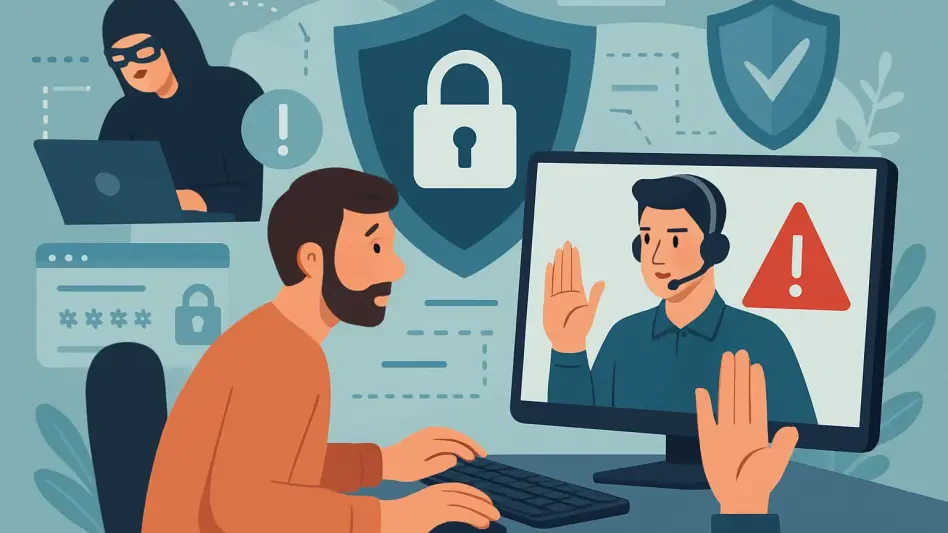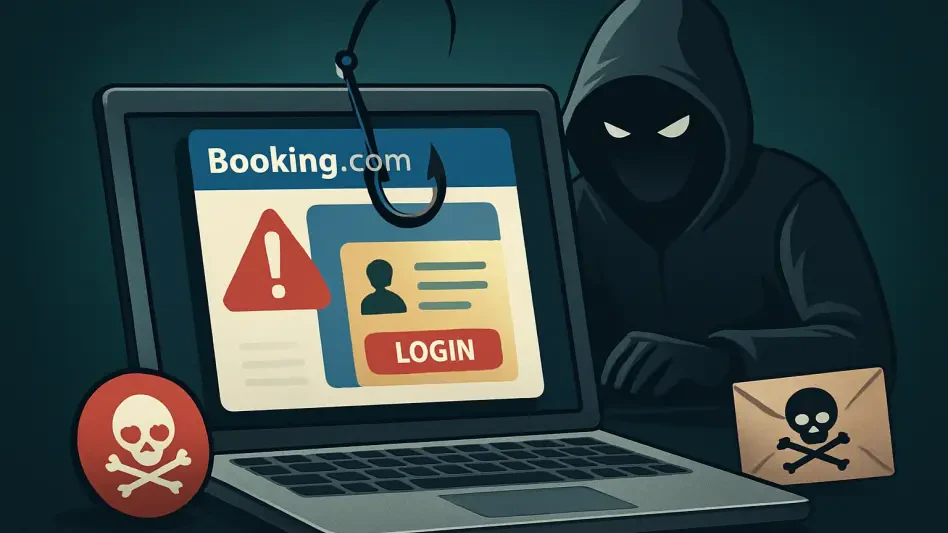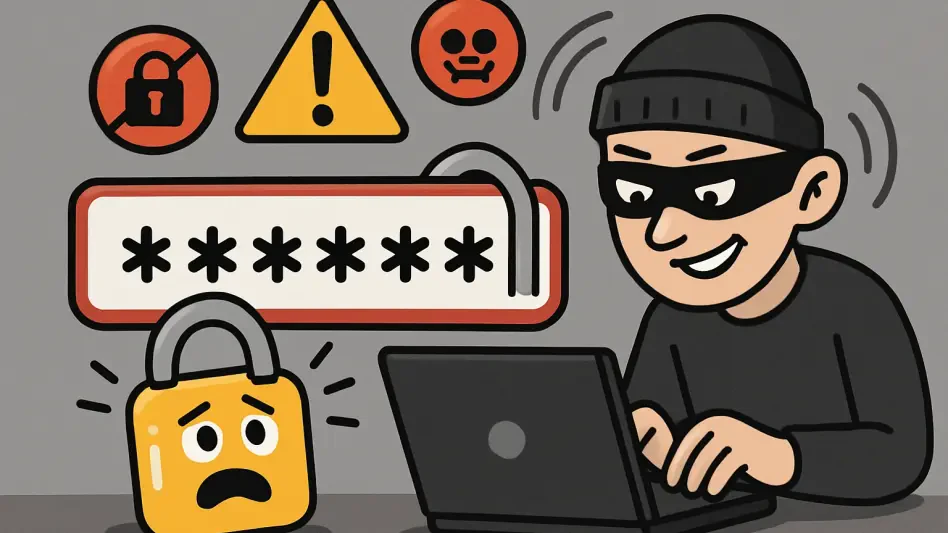In the ever-shifting terrain of digital security, human error remains a formidable obstacle for organizations striving to protect their systems from breaches, especially as technology races forward. Cybercriminals are harnessing advanced tools like artificial intelligence to create highly deceptive phishing schemes and deepfakes, turning user behavior into a critical vulnerability that leaders must address.
Understanding the Scope of Human Error
Prevalence and Impact of User Mistakes
The scale of human error in cybersecurity is staggering, with countless organizations grappling with the fallout of avoidable mistakes made by their workforce. According to the 2024 Kaseya study, 45% of firms identify poor user practices—such as susceptibility to scams or disregard for protocols—as their primary concern, while 44% point to inadequate security training as a close second. These numbers reveal a troubling reality: employees often become the weakest link in the security chain, not due to intent, but because of gaps in knowledge or guidance. Social engineering tactics, particularly phishing, exploit this vulnerability by tricking users into divulging sensitive information or clicking malicious links. The consequences can be devastating, ranging from data leaks to financial losses, emphasizing that human error is not a minor issue but a pervasive threat that demands immediate attention from leadership to prevent recurring incidents.
Compounding this challenge is the sheer variety of ways human error manifests in daily operations, often under the radar until a breach occurs. Employees may bypass security measures for the sake of convenience, such as using personal devices for work without proper safeguards or sharing passwords to streamline tasks. These seemingly small oversights can open doors to significant risks, especially when coupled with a lack of awareness about evolving threats. The Kaseya findings suggest that many organizations underestimate the cumulative impact of these behaviors, focusing instead on external threats while neglecting internal vulnerabilities. Leadership must recognize that addressing human error requires a proactive stance, starting with a thorough assessment of current user practices and identifying specific pain points. Only by understanding the breadth of this issue can companies begin to implement targeted strategies that mitigate risks at their source, rather than reacting after damage is done.
Shifting the Blame Narrative
Pointing fingers at employees for cybersecurity breaches often proves to be a shortsighted and unproductive approach that fails to address deeper systemic issues. Many workers are simply executing routine tasks—such as responding to emails or accessing urgent files—when they inadvertently expose systems to danger. Holding them solely accountable overlooks the reality that such actions are often inherent to their roles, leaving little room for error in high-pressure environments. Experts argue that this blame culture not only demoralizes staff but also distracts from the need to scrutinize organizational policies and infrastructure. A shift in perspective is essential, urging leaders to view breaches as symptoms of broader failures rather than isolated acts of negligence. This mindset encourages a more constructive dialogue about security, focusing on solutions that support rather than penalize the workforce.
Furthermore, the tendency to scapegoat individuals can stifle transparency, as employees may hesitate to report mistakes or suspicious activity for fear of repercussions. This reluctance creates a hidden layer of risk, where small errors fester into larger problems unnoticed. A notable example is the backlash against certain training exercises that punish rather than educate, such as controversial phishing simulations that shame participants for falling for traps. Such methods reinforce a punitive atmosphere, undermining trust between staff and management. Instead, the emphasis should be on fostering an environment where learning from mistakes is prioritized over assigning fault. Leadership plays a pivotal role in dismantling this outdated narrative, redirecting efforts toward building robust systems and support structures that reduce the likelihood of errors in the first place, while ensuring employees feel safe to engage openly with security protocols.
Evolving Threats and Organizational Gaps
Rising Sophistication of Cyber Attacks
The landscape of cyber threats has undergone a dramatic transformation, with attackers leveraging cutting-edge technologies like generative AI to craft attacks that are harder to detect and more damaging than ever before. Phishing emails, once easily spotted due to glaring errors, now appear polished and personalized, often mimicking legitimate communications with uncanny accuracy. This evolution, driven by AI, amplifies the risk of human error, as even cautious employees can be deceived by sophisticated scams. Deepfakes and voice spoofing further complicate the issue, blurring the line between genuine and malicious interactions. The rapid pace of these advancements means that traditional defenses are often outmatched, placing immense pressure on organizations to adapt swiftly. Leaders must acknowledge this escalating complexity and prioritize equipping their teams with the tools and knowledge to recognize these modern threats before they cause irreparable harm.
Adding to the urgency is the reality that these advanced attacks target human psychology just as much as technological vulnerabilities, exploiting trust and urgency to bypass rational scrutiny. Employees may receive urgent requests that appear to come from trusted sources, prompting immediate action without verification. The emotional manipulation embedded in these tactics makes them particularly effective, as fear or curiosity overrides caution. Statistics underscore the growing cost of such breaches, with firms reporting significant losses tied to user-driven incidents. Addressing this requires more than just awareness; it demands a strategic overhaul of how cybersecurity is communicated and reinforced across all levels of an organization. By staying informed about emerging attack methods and integrating real-time threat intelligence into their defenses, leaders can better prepare their workforce to navigate this treacherous digital terrain with confidence and skepticism.
Systemic Shortcomings in Security Design
Many cybersecurity failures attributed to human error actually stem from poorly designed systems that inadvertently encourage risky behaviors among employees. Policies like frequent password resets, intended to enhance security, often backfire by pushing users to create predictable patterns or reuse credentials across platforms. Similarly, the absence of multi-factor authentication (MFA) in many organizations leaves accounts vulnerable to compromise, even when employees follow basic guidelines. These foundational flaws reflect a disconnect between security design and human behavior, creating friction that undermines protective measures. Leadership must take responsibility for identifying and rectifying these gaps, ensuring that systems are intuitive and aligned with how people naturally operate. Only through such alignment can the burden of error be shifted away from individuals and toward more resilient infrastructures.
Beyond policy missteps, a lack of timely software updates and patches further exacerbates organizational vulnerabilities, often leaving known exploits unaddressed for far too long. Employees, unaware of these backend issues, continue to interact with outdated systems, unaware of the risks they face. This oversight highlights a critical lapse in proactive maintenance, where the focus remains on response rather than prevention. Experts emphasize that robust security starts with the basics—enforcing strong password protocols, deploying MFA universally, and ensuring systems are updated promptly. Leadership commitment to these fundamentals can drastically reduce the window of opportunity for attackers, even when human mistakes occur. By prioritizing user-friendly design and consistent system hygiene, organizations can create an environment where security complements rather than conflicts with daily workflows, ultimately minimizing the impact of inevitable human slip-ups.
Building a Stronger Defense Through Leadership
Cultivating a Security-Aware Culture
Transforming an organization’s approach to cybersecurity begins with nurturing a culture where security is everyone’s responsibility, not just the IT department’s burden. Employees must feel empowered to report suspicious activity or admit errors without fear of harsh judgment or penalties. Such transparency is vital, as concealed mistakes can escalate into major breaches if left unaddressed. Leadership plays a crucial role in setting this tone, demonstrating through actions and policies that errors are opportunities for growth rather than grounds for blame. Encouraging open communication builds trust, ensuring that potential threats are flagged early and addressed collaboratively. This cultural shift, though gradual, lays the groundwork for a resilient security posture, where every individual feels invested in protecting the organization’s digital assets from internal and external risks alike.
Equally important is the need to integrate security awareness into the fabric of daily operations, making it a natural part of the workplace rather than an afterthought. This means going beyond annual training sessions to embed reminders and best practices into routine processes, such as email workflows or onboarding programs. Leaders should champion initiatives that reward proactive behaviors—like spotting phishing attempts or suggesting security improvements—reinforcing the idea that vigilance is valued. A supportive environment also means providing accessible channels for reporting concerns, ensuring no barrier stands in the way of quick action. When staff see their contributions to security acknowledged and acted upon, their engagement deepens, creating a collective shield against human error. This cultural evolution, driven by consistent leadership focus, turns a potential weakness into a powerful line of defense against cyber threats.
Implementing Effective Training Programs
Training stands as a cornerstone in the fight against human error, but its impact hinges on delivery and relevance to real-world challenges faced by employees. Generic, infrequent sessions often fail to resonate, leaving staff ill-prepared for the nuanced threats they encounter. Instead, programs should be regular—ideally quarterly—and tailored to specific roles within the organization, ensuring content speaks directly to the risks each team faces. Incorporating interactive elements like simulations and gamification can transform learning into an engaging experience, boosting retention of critical concepts. For instance, mock phishing exercises that mimic current attack trends allow participants to practice discernment in a safe setting. Leadership must prioritize these dynamic approaches, recognizing that well-trained employees are not just less likely to err but also more likely to act as the first responders in identifying potential breaches.
Beyond engagement, the focus of training should be on practical, actionable skills that employees can apply immediately in their day-to-day tasks. Teaching staff to question urgent or unusual requests, for example, instills a healthy skepticism that can thwart social engineering attempts. Bite-sized learning modules, delivered through accessible platforms, ensure that lessons are digestible and don’t overwhelm busy schedules. Additionally, hands-on workshops where participants troubleshoot realistic scenarios can bridge the gap between theory and application, solidifying their ability to respond under pressure. Leadership support is critical here, not just in funding these initiatives but in actively endorsing their importance to the workforce. By weaving continuous education into the organizational rhythm, companies can cultivate a vigilant mindset among employees, significantly reducing the odds of costly mistakes driven by ignorance or oversight.
Staying Ahead of Emerging Risks
The relentless evolution of cyber threats demands that leaders adopt a forward-thinking approach, constantly updating their strategies to counter new attack vectors as they emerge. With AI-enhanced tactics becoming more prevalent, organizations cannot afford to rely on static defenses or outdated training content. Regular assessments of the threat landscape, informed by the latest intelligence, should guide updates to security protocols and employee education. This proactive stance ensures that staff are not blindsided by novel phishing techniques or other sophisticated scams that exploit human tendencies. Leadership must champion this adaptability, allocating resources to monitor trends and integrate cutting-edge insights into their cybersecurity framework. Staying one step ahead of attackers is not just a technical necessity but a strategic imperative that safeguards the organization’s future.
Moreover, instilling a mindset of ongoing vigilance among employees is equally vital in navigating this dynamic environment, as human error often stems from complacency or overconfidence. Encouraging a culture of skepticism—where staff routinely verify the legitimacy of requests or links—can serve as a powerful deterrent to impulsive actions that invite risk. Leaders should also facilitate access to real-time tools, such as threat alerts or verification systems, that empower employees to make informed decisions on the spot. Beyond individual responsibility, fostering cross-departmental collaboration ensures that insights about emerging risks are shared swiftly, preventing isolated vulnerabilities from becoming widespread issues. Reflecting on past efforts, leadership commitment to these adaptive measures proved instrumental in minimizing breaches, setting a precedent for sustained investment in anticipation and prevention over mere reaction.








